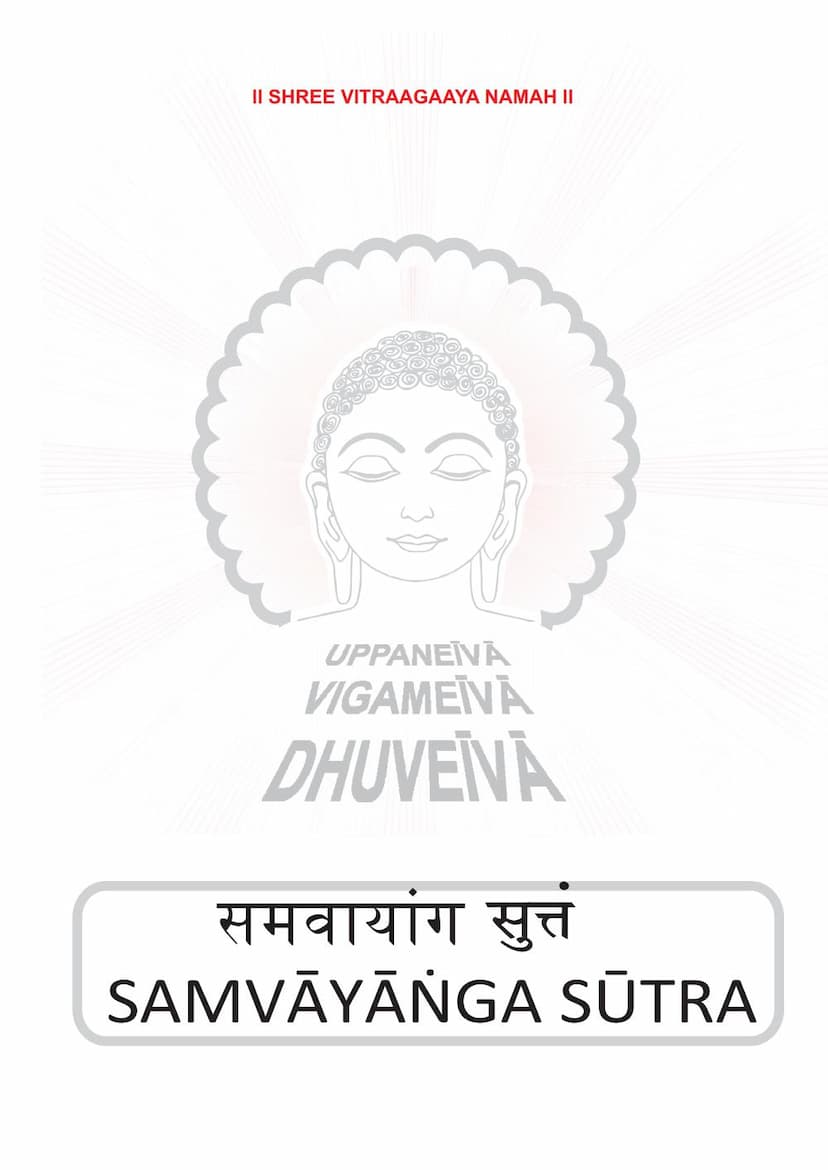Agam 04 Ang 04 Samvayang Sutra Mool Sthanakvasi
Added to library: September 1, 2025

Summary
Here's a comprehensive summary of the provided Jain text, the Samvayang Sutra (4th Anga of the Agam), based on the given pages:
Title: Samvayang Sutra (समवायांग सुत्त)
Author(s): Originally composed by Sudharmaswami (fifth Ganadhara of Bhagwan Mahavira), and the text was preserved and organized by Devardhigani Kshamashaman at the Vallabhi Council.
Publisher: Global Jain Agam Mission
Core Subject: The Samvayang Sutra, as indicated by its title ("Samvaya" meaning "collection" or "enumeration"), is a comprehensive catalog and enumeration of Jain cosmological, philosophical, and ethical concepts. It systematically lists and categorizes various Jain principles, entities, and phenomena based on numerical classifications, primarily starting from "one" and progressing upwards.
Key Features and Content:
- Numerical Classification: The Sutra's primary method is to enumerate items and concepts based on numbers. It starts by listing things that are "one" (e.g., one soul, one non-soul, one law, one un-law), then "two" (e.g., two types of danda, two types of bondage), "three," and so on, up to higher numbers. This structured approach makes the vast array of Jain teachings accessible and organized.
- Cosmological and Geographical Data: The text details various aspects of the Jain universe, including:
- Cosmic Entities: Descriptions of Mount Meru, the Jambudvipa continent, stars, constellations (nakshatras), different types of heavens (viman), hells (naraka), and their lifespans (ayu).
- Geographical Locations: Mentions of Jambudvipa, Bharat Kshetra, Airavata Kshetra, Mahavideha Kshetra, specific mountains (like Himavant, Meru), and their dimensions.
- Lifespans and Dimensions: Extensive lists of lifespans of beings in different realms (hell-dwellers, gods, humans, animals) in terms of Paliyopama and Sagopama. It also details the dimensions of celestial vehicles, mountains, and other cosmic structures.
- Philosophical Categories: The Sutra enumerates fundamental Jain philosophical concepts, such as:
- Dravya (Substances): Dharma, Adharma, Akash, Pudgal, Jiva.
- Karmic Principles: Enumeration of karmas, their bondage, influx (asrava), stoppage (samvara), shedding (nirjara), and liberation (moksha).
- Virtues and Vices: Lists of virtues, vows (mahavratas), ethical disciplines (samitis), faults (doshas), passions (kashayas), and negative states (vikathas).
- Soul and its States: Classification of soul states and its path to liberation.
- Ethical and Conductual Principles: The text details the essential principles of Jain practice:
- The Five Mahavratas (Great Vows): Non-violence, truthfulness, non-stealing, celibacy, and non-possession.
- The Five Samitis (Disciplines): Care in walking, speech, eating, handling objects, and excretion.
- The Nine-fold Classification of Conduct: Various classifications related to right faith, knowledge, and conduct.
- Brahma-charya (Celibacy): Detailed enumeration of restrictions and observances related to celibacy.
- Penances (Tapa): Distinguishing between external and internal penances.
- Biographical and Historical Information: The Sutra contains references to:
- Tirthankaras: Enumerations of Tirthankaras, their parents, pre-life names, life spans, ascensions, and their attendant trees.
- Ganadharas and Ascetics: Mentions of the Ganadharas of Mahavira and other prominent ascetics.
- Kings and Dynasties: References to Chakravartis, Baladevas, and Vasudevas, along with their lineages and achievements.
- Structure of the Jain Agam: The text itself is part of the vast body of Jain Agamas, and it explicitly lists the twelve Angas, providing a foundational understanding of the scriptural canon.
- Emphasis on Numbers and Quantities: A significant aspect is the precise numerical quantification of almost every concept discussed, from the number of cardinal virtues to the lifespans of celestial beings and the dimensions of the universe. This highlights the Jain emphasis on meticulous classification and understanding.
Purpose and Significance:
- Comprehensive Knowledge Repository: The Samvayang Sutra serves as a foundational text for understanding the breadth and depth of Jain philosophy and cosmology.
- Educational Tool: Its numerical and systematic approach makes it an excellent tool for memorization and teaching the core tenets of Jainism.
- Preservation of Knowledge: The efforts of Devardhigani Kshamashaman ensured the preservation and compilation of these teachings.
- Foundation for Further Study: By enumerating concepts, it provides a framework for deeper exploration of specific Jain doctrines.
Overall Impression:
The Samvayang Sutra is a monumental work of classification within Jainism. It systematically presents a vast amount of information about the Jain universe, its inhabitants, and the principles governing existence, all organized through numerical enumeration. It is a testament to the intellectual rigor and the desire for comprehensive understanding prevalent in ancient Jain tradition. The Global Jain Agam Mission's effort to publish and translate this text aims to make this rich heritage accessible to a wider audience, particularly the youth.